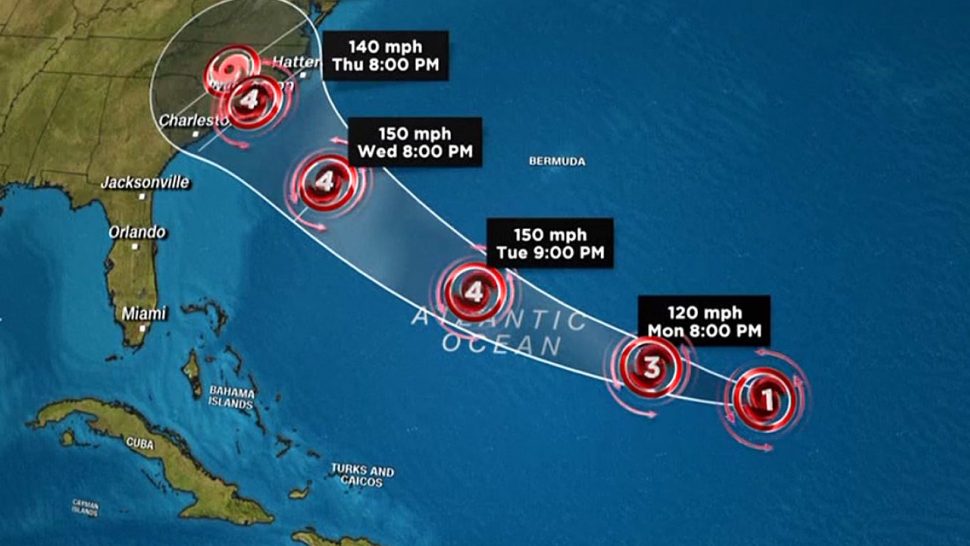HOLDEN BEACH, N.C., (Reuters) – Powerful Hurricane Florence grew larger today and is expected to bring days of rain, deadly flooding and power outages lasting weeks after it slams into the U.S. Southeast coast later this week.
Winds and massive waves will pound coastal North and South Carolina when Florence makes landfall on Friday, and its rains will take a heavy toll for miles inland, the National Hurricane Center (NHC) warned.
With winds currently at 140 miles per hour (225 km per hour), the storm was a Category 4 on the five-step Saffir-Simpson scale and expected to get bigger and stronger, the NHC said.
“This storm is a monster,” North Carolina Governor Roy Cooper told a Tuesday news conference about the most powerful storm to approach the Carolinas in nearly three decades.
 “It’s an extremely dangerous, life-threatening, historic hurricane … The forecast shows Florence stalling over North Carolina, bringing days and days of rain.”
“It’s an extremely dangerous, life-threatening, historic hurricane … The forecast shows Florence stalling over North Carolina, bringing days and days of rain.”
Cooper and his counterparts in neighboring South Carolina and Virginia ordered about 1 million people to evacuate coastal homes, including along the Outer Banks barrier islands. To speed evacuations, officials in South Carolina reversed the flow of traffic on some highways so that all major roads led away from the coast.
Communities in Florence’s path could be without electricity for weeks, said Federal Emergency Management Agency Administrator Brock Long.
The American Red Cross said more than 700 workers were headed to the target area while shelters were set up to take in those who could not evacuate. A hospital in Hampton, Virginia, was transferring patients to safer places.
The slow-moving storm, the most severe hurricane to threaten the U.S. mainland this year, was located about 785 miles (1,260 km) southeast of Cape Fear, North Carolina, at 4:30 p.m. EDT (2030 GMT), according to the NHC.
U.S. President Donald Trump on Tuesday signed declarations of emergency for North Carolina, South Carolina and Virginia, freeing up federal resources for storm response.
“We are sparing no expense. We are totally prepared,” Trump said at the White House, adding that the administration would go to Congress for emergency funding.
Trump faced severe criticism for his administration’s response to Hurricane Maria last year in Puerto Rico. Some 3,000 people died in the aftermath of that storm.
In addition to flooding the coast with wind-driven storm surges of seawater as high as 13 feet (4 m), Florence could drop 15 to 25 inches (38 to 64 cm) of rain, with up to 35 inches (89 cm) in some spots, forecasters said.
Not everyone was in a hurry to leave. Charles Mullen, 81, a longtime resident of Hatteras Island, North Carolina, said he had ridden out many storms and that most locals were planning to stay unless Florence took aim at Hatteras.
“If it decides to come here, we’re gone,” he said.
Residents prepared by boarding up their homes and stripping grocery stores bare of food, water and supplies. Some gas stations also ran low on fuel.
“We are in a very deadly and important game of chess with Hurricane Florence,” South Carolina Governor Henry McMaster said at a Tuesday news conference.
Wall Street was sniffing out companies that could gain or lose at the storm’s hands. Generator maker Generac Holdings Inc rose 1 percent and reached its highest price since April 2014.
Nuclear power plants in the area were preparing for the storm, with Duke Energy Corp’s Brunswick and Harris plants in North Carolina’s were most likely to be affected, said U.S. Nuclear Regulatory Commission spokesman Roger Hannah. He noted that Dominion Energy Inc’s Surry plant in Virginia could also be affected if Florence turns north.










